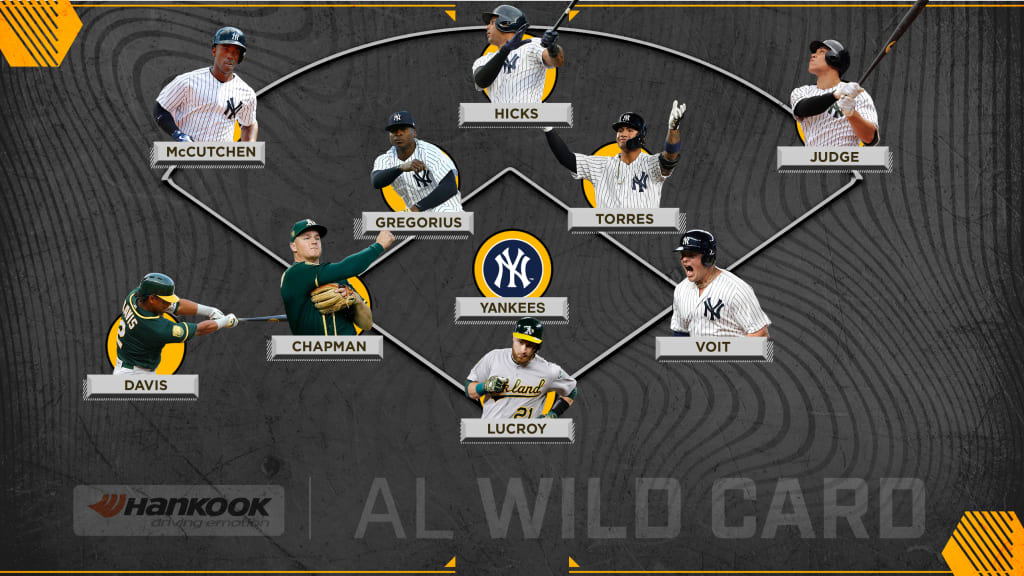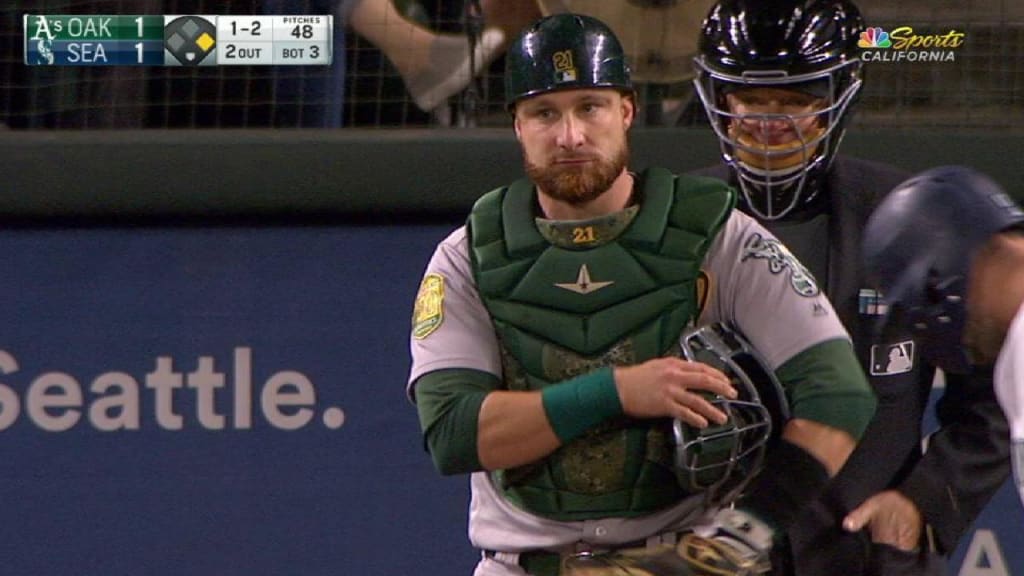Who has edge? A's-Yanks position by position

The Yankees had the third-most wins in baseball. The A's had the most after the All-Star break. They're two incredibly different teams, one almost disappointed to be here after entering the year with hopes of a division title, the other shocking the baseball world by coming out of nowhere -- and overcoming a near-endless run of pitching injuries -- to make it back to the playoffs for the first time since 2014.
Tonight in the Bronx, the Yankees and A's will fight for the right to go to Boston to challenge a Red Sox team that just won the most games in franchise history, but they have to make it there first. As we go position by position to break this down, a few things become clear. First, a few injuries for the Yanks could make a big difference in their lineup. Second, these two teams are more evenly matched than you'd think. Third, Yankee Stadium is the best hitter's park this side of Coors Field, and that could make a big difference if some lazy fly balls find their way over the fence. And fourth, this game is going to be about the bullpens, perhaps quickly.
Where is each team stronger? Let's find out.
:: AL Wild Card Game schedule and results ::
Catcher
One one side, the A's have a veteran catcher who used to be a strong hitter, but he isn't performing that way this year. (That's Jonathan Lucroy, .241/.291/.325, with four homers.) On the other, the Yankees have a high-upside hitter who hasn't hit at all this year and brings serious questions about blocking ability, albeit with a cannon arm. (That's Gary Sánchez, .186/.291/.406, with 17 homers.) While Lucroy has caught the most runners stealing this year, he's allowed the most, too. The A's don't try to steal bases (last in the AL with 56 attempts), which makes Sanchez's arm a moot point. There's talent on both sides, but flaws as well.
Tiny Advantage: A's
This browser does not support the video element.
First base
Luke Voit has been absolutely sensational since arriving in New York (.333/.405/.689), and he's clearly pushed Greg Bird out of a job. Matt Olson has much more of a track record (.246/.338/.492 for his career), but we're not picking names for the next five years.
Small advantage: Yankees
This browser does not support the video element.
Second base
Jed Lowrie (.267/.353/.448) and Gleyber Torres (.271/.340/.480) have hit about identically this year. Neither is much of a threat on the bases. They've both hit worse in the second half than they did in the first, when they each made the AL All-Star team, and the various defensive metrics disagree about who is better.
Tiny advantage: Yankees
This browser does not support the video element.
Shortstop
If we knew Didi Gregorius was fully healthy, this would be an easy call. After all, he's got a big hitting advantage (.268/.335/.494) over Marcus Semien (.255/.318/.388), and the game is in Yankee Stadium, which is perfectly built for Gregorius' lefty swing. The problem here is one of health, because it remains to be seen how much he'll be affected by his injured right wrist. If he's limited, or replaced by Adeiny Hechavarría, that's a big deal for the A's. For now, we'll take the optimistic route.
Small advantage: Yankees
Third Base
Miguel Andújar has had a phenomenal rookie season for the Yankees, putting up one of the most impressive rookie slugging seasons in franchise history. The problem for Andujar is that Matt Chapman has a big edge in OBP (.356) and similar slugging (.508) in a tougher park, making him a slightly more valuable hitter, and the defensive difference is massive.
Big advantage: A's
This browser does not support the video element.
Left field
With Brett Gardner struggling, Andrew McCutchen has taken over the left-field job for the Yankees, and he's been very good, hitting .253/.421/.471 for the Yanks after hitting .255/.357/.415 for the Giants. With Luis Severino taking the ball for New York, Oakland will go with left-handed hitter Nick Martini.
Advantage: Yankees
Center field
After months of Mark Canha and Dustin Fowler, the rookie Ramón Laureano took over the job in August, and his impact has been stunning, as he's hit .288/.358/.474 with strong defense, including a throw you just might remember.
This browser does not support the video element.
Of course, Aaron Hicks (.248/.366/.467) has been every bit as good in terms of OBP and slugging, and he's also done it with solid defense, especially on throws.
This browser does not support the video element.
It's true that Hicks missed some time with a left hamstring issue, though he returned to the lineup against Boston at the end of the season. If he's healthy, his track record gives him the edge.
Advantage: Yankees
This browser does not support the video element.
Right field
You wouldn't think there would be a conversation here, right? After all, Aaron Judge finished second in the AL MVP Award race last year, and he was well on his way to backing it up before breaking his wrist in July. Then again, Stephen Piscotty has had a quietly big year for Oakland, shaking off a slow start to hit .286/.351/.556 since June 1, one of the 15 best lines in baseball. Judge, meanwhile, has struggled since his return.
If we knew the Yankees were going to have full-strength Judge, they'd have the massive edge here. Though he managed to hit his first post-injury home run in Boston on Saturday, there's still some uncertainty here. But just due to his obvious skill and upside, Judge still gets the edge. If he's right in October, there's no one better.
Small advantage: Yankees
Designated hitter
Now we're talking, because in Khris Davis and Giancarlo Stanton, these two teams have two of the most feared sluggers in baseball as their designated hitters. (They have the most and fourth-most barrels, which is a Statcast™ metric that expresses batted balls struck with the optimal combination of exit velocity and launch angle.)
The Oakland Coliseum, remember, is a strong pitcher's park, yet Davis still has a large edge in slugging percentage, .549 to .509. That gets him the advantage here. Stanton, oddly, is one of the few Yankees to hit better away from the Bronx, putting up a .229/.311/.468 line at home against a .300/.374/.547 line on the road.
Small advantage: A's
This browser does not support the video element.
Pitching staff
When we've done this in years past, we've separated out starters and relievers into two categories. That almost seems quaint now, doesn't it? The A's are going to go with a stream of relievers, beginning with Liam Hendriks as "the opener." And even though the Yankees will use a traditional starter in Severino, he probably won't go more than twice through the order, if that. There aren't starters and relievers in a one-game playoff. There's just pitchers. There's just a path to 27 outs.
After June 1, the teams had identical ERA marks (3.74). In September, the A's had a 3.99 ERA ... and the Yankees have had a 4.05 ERA. That's not a perfect way to do it, of course; there's differences in park factors and opponents, and several September pitchers aren't going to be seen in October. Oakland probably has a deeper bullpen, but New York might get more length out of its starter.
This browser does not support the video element.
The point is, both sides are just full of power arms -- Blake Treinen, Aroldis Chapman, Jeurys Familia, Dellin Betances, Lou Trivino, Zach Britton, Fernando Rodney, Chad Green, Shawn Kelley, David Robertson and on and on and on -- and they won't be afraid to use them. It's how they got to this point. The one difference is the Yanks have a starting pitcher (Severino) who might give them a few innings, so that gives them a tiny edge.
Slight Advantage: Yankees
So who's going to win? Anything can happen, but given the injuries in the Yankees' lineup, we're going to be bold. The A's sluggers will look even better outside of their cavernous home field, and Bob Melvin has plenty of relievers to play with. Oakland will move on to Boston.
